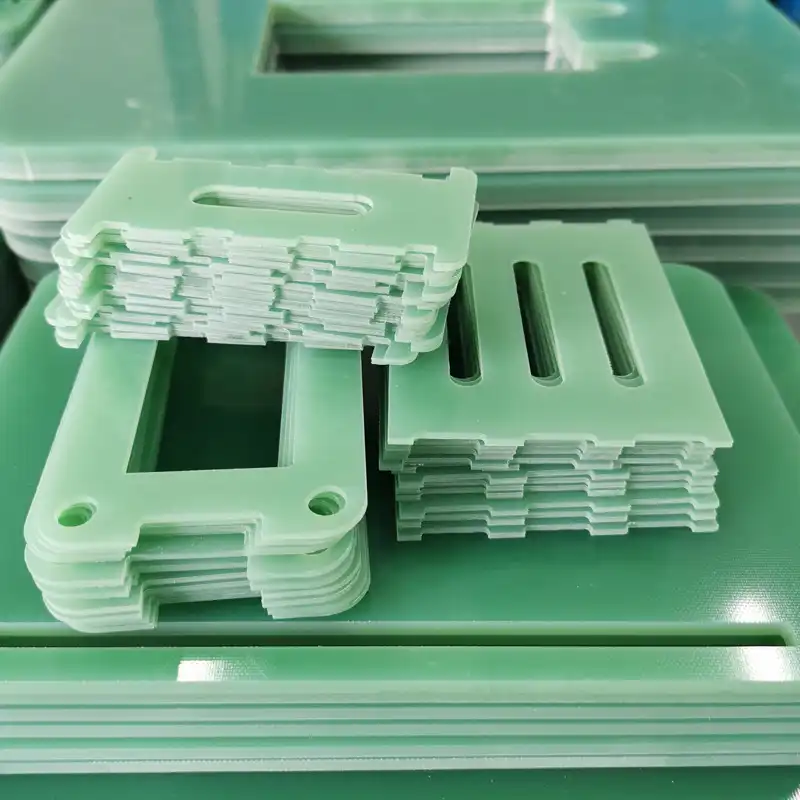Understanding the Composition and Manufacturing Process of G10 Fiberglass Sheet
Raw Materials and Their Contributions
G10 fiberglass sheet is crafted from a meticulous blend of high-quality materials. The primary components include woven glass fabric and epoxy resin. The glass fabric, typically made from E-glass fibers, provides the sheet with its remarkable strength and rigidity. These fibers are known for their excellent tensile strength and resistance to heat. The epoxy resin, on the other hand, acts as a binding agent, encapsulating the glass fibers and creating a cohesive structure. This resin is chosen for its superior adhesive properties, chemical resistance, and ability to withstand high temperatures without significant degradation.
The Layering Technique
The manufacturing process of G10 fiberglass sheet involves a sophisticated layering technique. Multiple layers of glass fabric are carefully arranged in a predetermined pattern, often with fibers oriented in different directions to enhance overall strength. This strategic layering is crucial in achieving the material's exceptional mechanical properties. The number of layers can vary depending on the desired thickness and specific application requirements. This multidirectional arrangement of fibers contributes to the sheet's isotropic properties, meaning it exhibits similar strength characteristics in all directions.
Heat and Pressure Treatment
Once the layers are assembled, the composite undergoes a rigorous heat and pressure treatment process. This stage, known as curing, is where the epoxy resin fully sets and bonds with the glass fibers. The material is subjected to carefully controlled temperatures and pressures in specialized equipment such as autoclaves or hot presses. This process ensures thorough impregnation of the resin into the glass fabric, eliminating any voids or air pockets that could compromise the material's integrity. The result is a dense, uniform structure with exceptional dimensional stability and resistance to environmental factors.
Exploring the Unique Properties of G10 Fiberglass Sheet
Mechanical Strength and Durability
G10 fiberglass sheet boasts impressive mechanical properties that make it a preferred choice in many high-stress applications. Its high tensile and compressive strength allow it to withstand significant loads without deformation or failure. The material's excellent impact resistance further enhances its durability, making it suitable for applications where sudden shocks or impacts are a concern. Additionally, G10 fiberglass sheet maintains its mechanical properties over a wide temperature range, ensuring reliable performance in diverse environmental conditions. This combination of strength and durability contributes to the longevity of components made from G10, reducing the need for frequent replacements and maintenance.
Electrical Insulation Capabilities
One of the standout features of G10 fiberglass sheet is its exceptional electrical insulation properties. The material exhibits high dielectric strength, meaning it can withstand strong electric fields without breaking down. This characteristic makes G10 an ideal choice for various electrical and electronic applications, particularly in high-voltage environments. Its low dielectric constant and dissipation factor contribute to minimal signal loss and distortion, crucial in high-frequency applications. Moreover, G10 fiberglass sheet maintains its insulating properties even in humid conditions, thanks to its low moisture absorption rate, ensuring consistent performance in varying atmospheric conditions.
Chemical and Environmental Resistance
G10 fiberglass sheet demonstrates remarkable resistance to a wide range of chemicals and environmental factors. The epoxy resin matrix provides excellent protection against corrosion, making the material suitable for use in harsh industrial environments. It resists degradation from exposure to oils, solvents, and many acids, preserving its structural integrity over time. The material's low water absorption rate contributes to its dimensional stability in humid conditions, preventing warping or swelling that could compromise its performance. Additionally, G10 fiberglass sheet exhibits good resistance to UV radiation and weathering, making it suitable for outdoor applications where exposure to the elements is a concern.
Applications and Future Prospects of G10 Fiberglass Sheet
Current Industrial Applications
G10 fiberglass sheet finds extensive use across various industries due to its versatile properties. In the electronics sector, it serves as a reliable substrate material for printed circuit boards, especially in high-performance applications where thermal stability and electrical insulation are crucial. The aerospace industry utilizes G10 for structural components, benefiting from its high strength-to-weight ratio and resistance to extreme temperatures. In the automotive field, G10 is employed in electrical insulation components and structural parts where dimensional stability under varying conditions is essential. The material's excellent machinability allows for precise fabrication of components, making it popular in the manufacturing of precision tools and fixtures.
Emerging Technologies and Potential Uses
As technology advances, new applications for G10 fiberglass sheet continue to emerge. In the renewable energy sector, G10 is being explored for use in wind turbine components, leveraging its strength and weather resistance. The material's excellent insulation properties make it a candidate for advanced energy storage systems, including cutting-edge battery technologies. In the field of robotics, G10 is being considered for structural components that require high strength, low weight, and electrical insulation. The material's potential in 3D printing applications is also being investigated, potentially opening up new avenues for complex, customized component manufacturing.
Sustainability and Environmental Considerations
As environmental concerns become increasingly prominent, the sustainability aspects of G10 fiberglass sheet are gaining attention. The durability and long service life of G10 components contribute to resource conservation by reducing the need for frequent replacements. Research is ongoing to develop more environmentally friendly manufacturing processes and explore the potential for recycling G10 materials at the end of their lifecycle. Some manufacturers are investigating the use of bio-based epoxy resins to reduce the environmental impact of G10 production. As the industry moves towards more sustainable practices, G10 fiberglass sheet is likely to evolve, potentially incorporating recycled materials or renewable resources in its composition.
Conclusion
G10 fiberglass sheet stands as a testament to the remarkable capabilities of composite materials. Its multilayer structure, combining the strength of glass fibers with the binding power of epoxy resin, results in a material that excels in mechanical strength, electrical insulation, and environmental resistance. From its crucial role in electronics to its expanding applications in aerospace and emerging technologies, G10 continues to prove its versatility and reliability. As industries evolve and new challenges arise, the unique properties of G10 fiberglass sheet position it as a material of choice for innovative solutions. Its ongoing development and adaptation to sustainability concerns ensure that G10 will remain at the forefront of material science, driving progress across various sectors.
Contact Us
To learn more about our G10 fiberglass sheet products and how they can benefit your projects, please don't hesitate to reach out to us. Our team of experts is ready to assist you with any inquiries and provide tailored solutions to meet your specific needs. Contact us today at info@jhd-material.com for more information or to request a quote.






